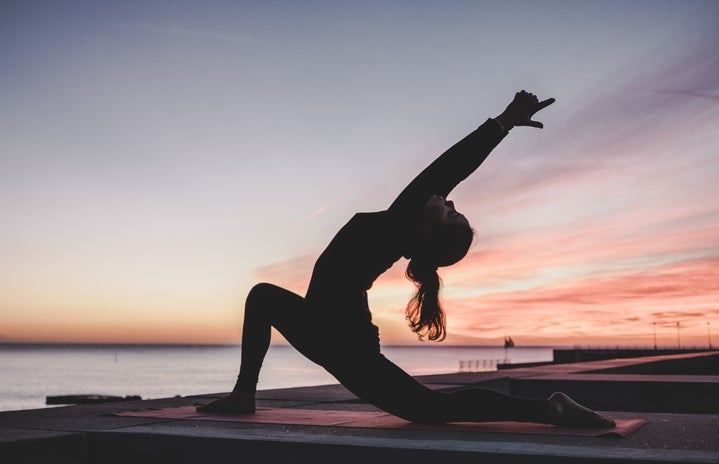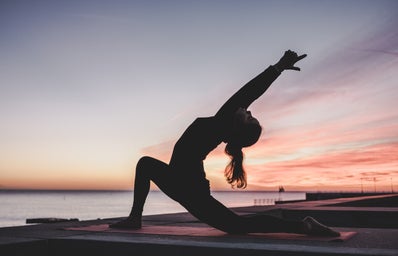I’m going to start with a disclaimer: I am not a personal trainer, fitness expert, or even an athlete. I’m just an average college girl who is trying to figure out the whole “staying healthy” thing for herself. This article is merely a narrative about my personal exercise journey that has gotten me through many ups and downs.
I am about as average as they come: 5’4” and three-quarters (every last bit counts), and since freshman year I’ve weighed in around 138 lbs. Yes, I just admitted my weight on the Internet and now I can never take it back, but that’s because I’m trying to prove to you that I am average. But I’ve also had some experiences that have caused sudden weight loss or some weight gain, so I can also relate to those outliers. The reasons for the weight fluctuation is a topic for another article, but I can tell you that my lowest weight was 110 lbs and my heaviest was – well, okay, I might not want that to be frozen into a block of cyber carbonite. Anyway, let me get back to my original point. You can whip yourself into better shape without running. I promise.
How do I know? Well, for starters, I hate running. There, I said it. A multitude of downsides to running regularly exist, such as wearing-down cartilage and eroding fat-burning muscle. If you don’t believe me, read this article, which explains why structured cardio exercises –running in particular – are not the best for weight loss. Rather, personal trainers and health professionals recommend interval training.
Intervals boost heart rate variability and muscle strengthening to increase calorie burning well after your workout has finished. Plus, there’s no single method or type, so you can find a regimen or style that not only gets you fit, but it might actually be (dare I say it?) FUN!
On the second page I’ve compiled a few types of interval-based workouts that I have used in the past two years with noticeable results.
Then, on the third page, I’ll finish with some useful tips for any type of workout.
[pagebreak]
The Gym. The first thing you probably thought of when you saw the title of this article is the gym, and that’s great. Most colleges have free gyms and fitness centers, so students should definitely try to take advantage of them.
First, figure out what you want to get from working out at the gym. Do you want to build muscle? Do you want to lose inches? Do you want to do both? These are important questions to ask because you will use different machines and/or use the same machines differently. To make it simple, high resistance (usually accompanied by fewer repetitions) is conducive to building big muscle, while low resistance with more repetitions is better for building lean muscle. If you have never used a certain machine before, just ask someone for help. You can ask the fitness center attendant – I know this because I am one – or another patron. Some of the best tips I’ve learned in the gym have been from other people working out next to me.
Second, form and posture are very important. Whether you are doing deadlifts or using a variable resistance machine, your stance can make or break the workout. The impacts of improper form can be as innocuous as minimized effect or as hazardous as seriously injuring yourself. If you don’t know what you’re doing or how to do it, just ask.
Third, to get the best workout, limit downtime between sets and optimize muscle exertion. By that I mean when you’ve finished x-number of repetitions in the first exercise, say the shoulder press, take a quick, less-than-10-seconds break and then do an exercise that works another muscle group, like bicep curls. Rotate through a few workouts for three (or more!) sets each and you will feel the burn.
Workout Programs. There are a plethora of workout programs in the market right now; some of the most well known include Insanity, P90X, and Jillian Michael’s Ripped in 30.
Since Marymount lets students rent any of these DVDs for free, I’ve tried them out, namely Insanity and Jillian Michael’s workout regimens, and – I’m going to be perfectly honest with you – they’re not easy. During the first week I was so sore that I didn’t think I could make it through another DVD, and, after a couple weeks, I got bored with recycling the same workouts. Nonetheless, I have to admit that they have helped me slim down, particularly my thighs and hips. Also, they are very cardio heavy (gasp, not cardio!). Yes, I did the dreaded cardio, but these routines incorporated cardio intervals (there’s that word again) and circuits, and my stamina increased tenfold. I’ve stopped following the whole “regimen” thing lately, but still do an Insanity DVD once a week to get my much needed cardio exercise in.
Bodyweight Resistance. If you are like me, then you prefer having control over your workout plan, changing it up depending on your mood or what body part you want to focus on that day. This is the main reason why my Insanity kick didn’t last that long.
A few months ago I was introduced to the world of bodyweight resistance, where the primary – if not the only – workout apparatus is your own body. I actually learned about it through some of the free fitness classes that Marymount offers, such as Cardio Blast Kickboxing and Core & More. It involves countless exercises and moves that you can find at many sites such as here, here, and here. If you want more guidance, but not strictly timed and regimented like the aforementioned workout programs, I recommend checking out Blogilates. A friend introduced me to this site a couple months ago (shout out to Emilia!), and I’m obsessed. The trainer, who has been teaching Pilates for more than seven years, has short five to 15 minute videos that focus on different areas, themes, and experience levels. I loved that I could look up individual videos on anything from abs to legs and thighs without having to create an account. If you sign up, you gain access to so much more, but I don’t see myself getting bored with the basic benefits anytime soon. Before I started bodyweight resistance I could do about 20 pushups until my arms and back got tired. Now, I’m busting out 50+ and I’ve even worked my way up to having my feet elevated on the coffee table. True story.
[pagebreak]
Now, I will leave you with some final words of advice that you can apply to any type of workout or exercise routine.
1. Mix it up. Do something different every day you work out. Your muscles begin to remember the movements you do, and then start working more “efficiently.” In other words, your body will find how to burn fewer calories doing the same thing over and over again, so you will benefit from doing different types of workouts and various exercises. Also, it can keep you from getting bored.
2. Sweat every day. This one’s pretty self-explanatory: you sweat when you’re exerting yourself physically. Thus, if you’re sweating, you’re probably working your body big time. Bing, bang, boom!
3. Focus on getting stronger. You build muscle by pushing your muscles, resting, and then pushing them more, so whether it be between sets or between days, always try to do more.
4. Stay safe. All this being said, just keep in mind that you should never feel bad pain – that’s the difference between “I can feel the burn” and “I can see the bone.” Take care of yourself and your body will thank you.

